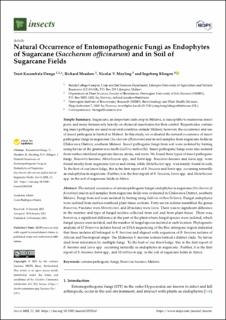| dc.description.abstract | Simple Summary Sugarcane, an important cash crop in Malawi, is susceptible to numerous insect pests, and many farmers rely heavily on chemical insecticides for their control. Biopesticides containing insect pathogens are used in several countries outside Malawi; however, the occurrence and use of insect pathogens is limited in Malawi. In this study, we evaluated the natural occurrence of insect pathogenic fungi in sugarcane (Saccharum officinarum) and in soil samples from sugarcane fields in Chikwawa District, southern Malawi. Insect pathogenic fungi from soil were isolated by baiting using larvae of the greater wax moth (Galleria mellonella). Insect pathogenic fungi were also isolated from surface-sterilized sugarcane leaves, stems, and roots. We found three types of insect pathogenic fungi: Beauveria bassiana, Metarhizium spp., and Isaria spp. Beauveria bassiana and Isaria spp. were found mostly from sugarcane leaves and stems, while Metarhizium spp. was mainly found in soils. To the best of our knowledge, this is the first report of B. bassiana and Isaria spp. occurring naturally as endophytes in sugarcane. Further, it is the first report of B. bassiana, Isaria spp. and Metarhizium spp. in the soil of sugarcane fields in Africa. Abstract The natural occurrence of entomopathogenic fungal endophytes in sugarcane (Saccharum officinarum) and in soil samples from sugarcane fields was evaluated in Chikwawa District, southern Malawi. Fungi from soil were isolated by baiting using Galleria mellonella larva. Fungal endophytes were isolated from surface-sterilized plant tissue sections. Forty-seven isolates resembled the genus Beauveria, 9 isolates were Metarhizium, and 20 isolates were Isaria. There was no significant difference in the number and type of fungal isolates collected from soil and from plant tissue. There was, however, a significant difference in the part of the plant where fungal species were isolated, which fungal species were isolated, and the number of fungal species isolated at each location. Phylogenetic analysis of 47 Beauveria isolates based on DNA sequencing of the Bloc intergenic region indicated that these isolates all belonged to B. bassiana and aligned with sequences of B. bassiana isolates of African and Neotropical origin. The Malawian B. bassiana isolates formed a distinct clade. No larvae died from infestation by multiple fungi. To the best of our knowledge, this is the first report of B. bassiana and Isaria spp. occurring naturally as endophytes in sugarcane. Further, it is the first report of B. bassiana, Isaria spp., and Metarhizium spp. in the soil of sugarcane fields in Africa. | en_US |

